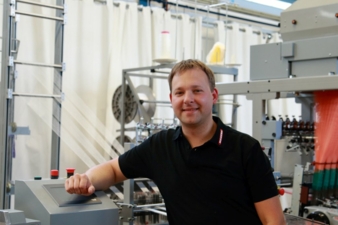16/08/2019 – Novotechnik — auf Deutsch lesen
Position sensors on the path to Industry 4.0
As we progress towards Industry 4.0, communication capabilities are becoming a must in the field of sensor technology. IO-Link is paving the way for this advancement.
In industrial and mobile automation, position sensors have to meet many requirements. Not only must they be designed with robustness, speed and precision in mind, but they must also be able to communicate – particularly in the context of Industry 4.0. IO-Link is fully exploiting the sensors’ “intelligence” in complete automation systems. This is giving rise to considerable added value without increasing cost. A good example are the magnetic linear position transducers from Novotechnik, which are fitted on the new textile machinery from Mageba International to detect the position of the dancers.
The arrival of rotary sensors in the digital world
In the field of angular and linear position measurements, there is now a trend towards touchless procedures designed to rule out downtimes caused by wear and tear. Magnetic operating principles are often preferred. Sensors, using e.g. the Hall effect, deliver absolute measurements, work reliably even in harsh conditions and are suitable for many applications in mechanical engineering on account of their low cost compared to other methods. Rising production volumes, fewer varieties thanks to standardised angle ranges, optimised production processes and value for money now make them a serious competitor to sensors based on potentiometers. Textile machinery producer Mageba, for example, is equipping its new Industry 4.0-compatible dyeing and setting machinery for narrow goods with magnetic rotary sensors and an IO-Link interface from Novotechnik.
In the sensors from the company’s RFC-4800 series, the sensor element and position-finding magnet are separated. Given that the sensors operate touchlessly and without moving parts, there is no mechanical wear and tear; the position marker is the only moving part. This design also simplifies assembly, as the sensor can be positioned up to 5mm away from the position marker. A marking indicates the correct alignment to the sensor. Being that the operating distance is variable, application-specific installation tolerances do not pose a problem.
Dancer position recognition in the finishing of narrow goods
“Our new dyeing and setting machines adapt to the respective production requirements and are able to process both elastic and non-stretch polyester or cotton materials. The spectrum extends from rubber goods, e.g. for sportswear and laces, to safety belts, cargo tie-downs and belts for roller blinds,” explains Maik Roth, Process Automation Technician at Mageba. In the modern systems, the grey goods are automatically dyed, stiffened or, if necessary, made flame-retardant and then dried in different zones to set the dye and any other finishes.
During this process, the speed of the belt conveyor has to be controlled with precision. To ensure the motion of the many spools remains constant, the machines operate with what are known as dancers. The rotary sensors are mounted in the fulcrum of the dancers. They detect the current position of “their” dancer indicating the continuously falling amount of tape on the spool. This information allows the speed of the corresponding spool drive to be adjusted, variations in the unwinding speed to be offset and the thickness of the tape to be taken into account when setting the rate of feed. “The latter is important when changing the product and before stretching,” adds Roth. “If the speed were not controlled responsively, it would lead to torn tapes and machine downtimes.”
Communication via IO-Link
One new finishing machine for narrow fabrics is generally fitted with around 20 magnetic rotary sensors. Given that the communication capability of the position sensors is the main focus of attention in the context of Industry 4.0, IO-Link is a topic of central importance. “The sensors not only permit bi-directional communication, but thanks to the digital output signals, they are also more EMC-resistant than conventional conductive plastic potentiometers,” states Roth, adding, “During commissioning, we can also change parameters such as the point of origin or the direction of rotation, helping us to reduce the diversity of variants in the warehouse.”
Besides data on position, other information such as status and diagnosis reports can be exchanged. Errors in the control circuit can be located more quickly, as the setting parameters are saved centrally. This means that a sensor can be swapped over quickly and simply re-parametrised as all the data is stored in the control system. “The type of sensor we chose, which has an anti-twist M12 screw fitting, means there is no longer any need for an electro-technically skilled member of staff to be present at the machine,” Roth concludes.
The decision to opt for the magnetic rotary sensors was also swayed by the high degree of protection and their robustness. They meet the requirements of the IP69 protection category and are able to withstand extreme exposure to dust, moisture and chemicals, so typical for textile machinery. The position-finding magnet and the receptor with evaluation electronics are completely encapsulated, enabling them to withstand temperatures from -40 °C to +105 °C.
The sensor’s simple assembly, reliability and robustness make it suitable for many other applications. Besides industrial settings, it is also ideal for mobile transportation solutions. After all, it can withstand vibrations and oscillations up to 2,000 Hz and knocks up to 100 g (6 ms, in compliance with IEC 60068-2-6) and, as a redundant model, it is also suitable for safety-specific applications in compliance with DIN EN ISO 13849.
About Mageba
Mageba International GmbH, headquartered in Bernkastel-Kues, was established in 1957 and has evolved into an innovative partner for the tape and narrow goods industry. The medium-sized business is a leading manufacturer of textile and special machinery for the textiles industry with a focus on narrow fabrics. Mageba sells its products globally and is supported by a network of representatives in more than 20 countries.
About Novotechnik
Established in 1947 and headquartered in Ostfildern, Germany, Novotechnik is a pioneering force in the further development of measuring technology. In Germany alone, more than 200 members of staff are working on ground-breaking technology. This has resulted in high-performing linear position transducers and rotary sensors which have become indispensable for production, control and measuring technology and the automotive industry around the world. The wide spectrum of products includes linear position transducers, rotary sensors based on various sensor principles, special solutions for the automotive industry as well as transducers and measuring units, covering all imaginable tasks; bespoke solutions are created for special needs and applications.
Stefan Sester, Novotechnik, and Ellen-Christine Reiff, Redaktionsbüro Stutensee





